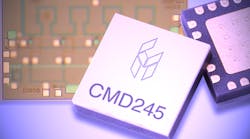Phase noise, which can limit the performance of communications, radar, and many other systems, is usually associated with oscillators. But as a presentation by Custom MMIC president and CTO Paul Blount at EDI CON will detail, phase noise can increase as a result of other components in a system, including amplifiers. Fortunately, with proper awareness, system phase noise can be controlled.
The presentation, “Conquering Phase Noise in Radar and Communications Systems,” is scheduled to start at 10:20 a.m. Wednesday, Sept. 13, in room 108. Blount, who is also a lead engineer for the company, will explain how additive phase noise can create problems in many RF/microwave systems, with phase noise contributed from unexpected sources, such as amplifiers.
Blount will review differences among semiconductor technologies, such as GaAs and GaN, and how the phase-noise mechanisms for the different semiconductor technologies. He will provide guidance on reducing system-level phase noise through the careful selection of key components, as well as present information on new lines of Custom MMIC’s unique low-phase-noise amplifiers (LPNAs).
Visitors to Custom MMIC on the show floor (at Strand booth No. 630) can learn more about the company’s families of broadband LPNAs (see figure), such as the CMD245 and CMD247. The CMD245 features 18-dB gain from 6 to 18 GHz, with noise figure of 3 dB and output power of +18 dBm at 1-dB compression. For millimeter-wave applications, the CMD247 achieves 13-dB gain from 30 to 40 GHz with 5-dB noise figure and +13.5-dBm output power at 1-dB compression. The phase noise for both MMIC amplifiers is exceptionally low, at −160 dBc/Hz or better. The LPNAs help to drop the total system phase noise in a variety of applications, including as local oscillator (LO) driver amplifiers and receiver front-end amplifiers for commercial and military systems.

